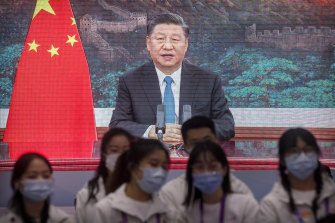Europe is provoking the world with its controversial plan to fight climate change

The global context for carbon pricing is evolving rapidly, with the European Union announcing the world’s most ambitious response to climate change and China about to launch the world’s largest emissions-trading market.
On Wednesday the EU unveiled its plan – dubbed “Fit for 55” – to reduce the bloc’s net greenhouse gas emissions by at least 55 per cent below 1990 levels by 2030.
The EU’s controversial plan would impose a carbon tax on imports from countries with lesser emissions reduction targets and carbon prices.Credit:EPA
On Friday China is expected to release details of a domestic emissions-trading market aimed at helping it to meet its target of peak emissions in 2030 and net zero emissions by 2060.
Of the two, the EU plan is the more controversial because it contains an extra-territorial dimension – the much-foreshadowed and very controversial carbon border tax that would impose a carbon tax on imports from countries with lesser emissions reduction targets and carbon prices.
That proposal, while central to preventing EU companies from being put at a competitive disadvantage to competitors that don’t have to pay a price for their emissions, is likely to face challenges at the World Trade Organisation.
However necessary to ensure European companies aren’t disadvantaged by the EU’s ambitious emissions goals, a carbon border tax can be characterised – and has been characterised – as a form of protectionism.
Even within the EU the plan, which it envisages will start to bite in 2023, is likely to face opposition from some of its 27 member countries, given that the proposals will have varying impacts on their economies.
The EU already has arguably the world’s most ambitious response to climate change. It launched its emissions trading system in 2005 and has reduced its emissions, from 1990 levels, by nearly 25 per cent.
That trading system would be remade to include a range of big industrial sectors – steelmakers, power generators, shipping, transport and buildings – not previously taxed by the scheme.
Carmakers would be included and their emissions standards raised to effectively phase out new petrol and diesel vehicles by 2035. Agriculture, not currently covered by the ETS, would face emissions caps.
The EU plan will intensify the global debate about reducing global carbon emissions further and faster than now envisaged and about the best mechanisms for achieving those outcomes.Credit:Jonathan Carroll
China’s trading scheme will start with more than 2000 companies in its power generation sector – a major source of global emissions – before being extended to the petrochemicals, building materials, steel and metals, paper and aviation industries over the next few years.
In an indication of how complicated the politics of carbon pricing are, even in Europe, the EU proposal includes a plan to use some of the estimated €9 billion ($14.25 billion) a year of revenue raised by the carbon border tax to fund a €72.2 billion program to offset the impact of the proposals on vehicles and buildings for households facing higher fuel and heating costs.
Underscoring that complexity, there may be different treatment of economies even within the EU, with concessions made to the weaker economies in southern Europe and the poorer countries in central and eastern Europe. The EU plan may involve issuing free credits to those economies (and consequent heavier lifting by the stronger ones) for a decade or more.
Any concessions could, of course, strengthen a WTO case against the border tax, although it will initially have limited application – imposed on products like steel, cement, aluminum and fertilisers. Russia and Turkey and some eastern European economies will be worst hit.
The US, China, Russia and others (including Australia) have objected to the concept of a border tax (although the US has suggested it might introduce one of its own) and its imposition could provoke retaliatory taxes and a rekindling of a trade war with the US that has only recently abated.
As it is imposed more widely, both to level the playing field for European companies and to prevent “carbon leakage,” or European companies relocating to jurisdictions with less punishing emissions standards, companies will have to make up the difference – pay a tax—on any gap between the carbon price, if any, they pay in their home market and the EU’s regime.
By phasing in the border tax, which would start in 2026, the EU probably wants to give companies – its own and those of other countries – time to understand and prepare for what will be a very complex scheme, with exporters to the EU probably having to produce audits of their emissions.
The initial limited application may also be designed to defuse a blowback from outside the EU.
The US, China, Russia and others (including Australia) have objected to the concept of a border tax (although the US has suggested it might introduce one of its own) and its imposition could provoke retaliatory taxes and a rekindling of a trade war with the US that has only recently abated.
China is expected to release details of a domestic emissions-trading market aimed at helping it to meet its target of peak emissions in 2030 and net zero emissions by 2060 on Friday.Credit:AP
By announcing it, however, the EU might be able to achieve its objective, and magnify the impact of its response to climate change, by intensifying discussions of alternatives, particularly the concept of a global minimum carbon price that is being promoted by some of the world’s multi-lateral institutions and international organisations representing fund managers pursuing sustainable investment strategies.
A global floor price, or a mechanism that imputed a price depending on countries’ progress towards net zero emissions, would be a less onerous and fairer approach without the protectionist flavour of the EU’s border tax plan.
What the EU moves will do is to intensify the global debate about reducing global carbon emissions further and faster than now envisaged and about the best mechanisms for achieving those outcomes.
That would further increase the pressure on economies, like Australia, that don’t have an emissions-trading or pricing system in place, whatever their stated ambitions or progress towards net zero emissions might be.
Much may depend on what the US does. The Biden administration does have very ambitious plans to reduce US emissions – Biden has committed to cutting them 50 per cent by 2030 and have a net neutral power system by 2035 – but is struggling to get the infrastructure elements of its program through Congress and the attempt to freeze new oil and gas leases on federal land through the courts.
If the US were to mirror the EU carbon border tax and the EU’s emissions goals, or adopt policies that could produce similar outcomes (regardless of whether China actually follows through on its commitments) they would create irresistible pressure for the rest of the world to follow suit in order to avoid being priced or locked out of at least two of the world’s three biggest markets.
The Business Briefing newsletter delivers major stories, exclusive coverage and expert opinion. Sign up to get it every weekday morning.
Most Viewed in Business
From our partners
Source: Read Full Article



